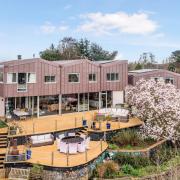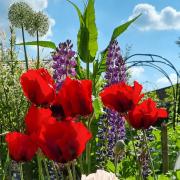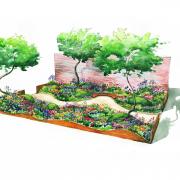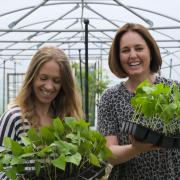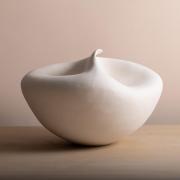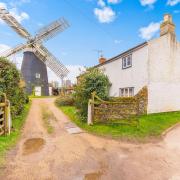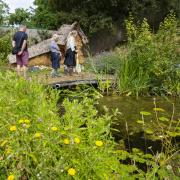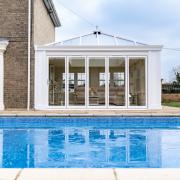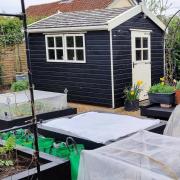Barbara Segall has received the coveted Garden Media Guild Outstanding Contribution Award for 2023 and is already talking about a 14th book on plants and gardens. So watch this space. Today, however, we’re strolling through her town centre garden in the middle of Sudbury, which is packed with so much interest it’s hard to tear yourself away.
Inside this 88ft x 44 ft space, walled on two sides, are acer, quince and crab apple trees, bearded irises, miscanthus grass, fragrant sweet box, and healthy roses, including a lovely arbour clothed in the rambling yellow banksia rose 'Lutea'. As with any successful small garden, you can’t see it all at once and, as we wind our way down, there’s much more. Barbara describes herself as a forager, ‘not just in hedges but in the garden’, and I’m struck by the plants that produce edible fruits or foliage.

An espalier frame is clothed in tayberry and red-fleshed apple ‘Redlove Era’. ‘It’s sharp so I use it in salads or cook it’. There’s a thornless blackberry ‘my absolute favourite’, a fig, a sea buckthorn for Vitamin C and a Szechuan pepper – Chinese stir fry anyone? Then there’s the April-flowering Amelanchier, or June berry. ‘You can use its fruit in sweet and savoury sauces,’ she says, ‘and I just love it as the foliage is beautiful.’
Raised beds contain artichokes and kale but, above all, herbs. Put her on a desert island and herbs – preferably chervil and basil – would be her choice of plant. It’s no surprise that of her 13 books four major on herbs and their uses (she’s also a past editor of Herbs magazine), and another is all about growing food in small gardens.

She has written the foreword for a recently re-published book called Wild Fruits, Berries, Nuts and Flowers by B James, who Barbara has been unable to trace. ‘It was a little wartime pamphlet book I had on my shelf for years. It had recipes for sloe gin and for everything you might forage.’ She showed it to one of her publishers who snapped it up and published a facsimile. ‘People are now doing foraging really very seriously,’ she says.
Barbara’s remarkable portfolio includes Beautiful Borders, a step-by-step guide, and Pots & Plants for inspiring your outdoor spaces. Her books have delighted gardeners across the UK and Europe, and in America where her first book, The Holly and the Ivy, was published, along with a UK version at the same time. She toured the gardens of Spain and Portugal for a Mitchell Beazley guide and teamed up with award-winning photographer Jerry Harpur for an eye-catching volume called Gardens by the Sea. Her Secret Gardens of East Anglia with Marcus Harpur came in 2017 and her latest in that series was Secret Gardens of the South East with Clive Boursnell, published in 2022.

When I show her a long list of her awards and achievements – some current, others earlier – she says lightheartedly: ‘I think you can pick and choose!’ I’m now looking at a picture of Barbara with a (pretend) sheep, taken in 2013 when she gained the Freedom of the City of London following her membership of the Worshipful Company of Gardeners. ‘It entitles me to drive sheep across London Bridge,’ she laughs.
She’s also been a fellow of the Chartered Institute of Horticulture since 2003 and is editor of its magazine, The Horticulturist. There’s much, much more but, closer to home, she’s an assistant county organiser for the National Gardens Scheme, she helped to set up the Suffolk Gardens Trust, also editing their newsletter, and she’s recently become a regular contributor to the gardening programme on Suffolk Sound.
The longer I spend with Barbara, the more I understand how richly deserved that Outstanding Contribution Award is. She follows a line of distinguished recipients including Beth Chatto, Christopher Lloyd, Roy Lancaster and Alan Titchmarsh. Who does she most admire?
‘Oh, all of them, absolutely. I mean, I’m completely honoured. I see myself as a person from a small town in a faraway place and it’s amazing to have come here and had such a happy working life.’ That faraway place is KwaZulu-Natal, South Africa. Barbara spent her childhood in a village by the Indian Ocean where the plants were semi tropical – ‘so different to what we have here’. With a touch of humour, she mentions her B for Botany at Durban Girls’ College in 1965 when writing about plants wasn’t even on the horizon, although she did go on to become a journalist, learning her trade at the Durban Daily News. But the seed was sown, as the saying goes.

‘My mother was a great gardener and so was my grandmother, so that’s really where it all started.’ Her parents were the first generation of both their families to live in South Africa. ‘They came from Scotland and Europe and I felt it was almost accidental that we were living there. All people like me wanted to do in their early 20s was travel and get away from this place at the end of the continent and go to Europe. So that’s what I did – came to London. Why wouldn’t you?’ she laughs.
She revelled in her London life on the staff of a food magazine, renting flats and bedsits, meeting people, and ‘spending nearly all my money on going to the ballet and the opera which was cheaper then.’ She rented a plot on the Fulham Palace allotments, part of the old palace grounds. ‘You weren’t allowed to dig down very far in case you found any archaeological treasures. All good fun!’ It helped to engender a desire to move to the countryside, but why Suffolk?
‘Well, going west was really expensive, but coming to East Anglia I could afford to get a house with a lovely garden. That was Holly Cottage at Newmans Green, near Sudbury, where she gardened on three-quarters of an acre. Her parents, who had also moved to London, loved coming to Suffolk. ‘They thought my house was their holiday home!’ It was also the inspiration for getting immersed in the world of gardens and in the mid 1980s, she enrolled on a course at Otley College, a certificate in Amenity and Decorative Horticulture.
‘There were more gardening magazines then and I thought, that’s what I want to do.’ So she went freelance and, it being the 1980s before we all started emailing, she pitched her ideas for features directly to magazine publishers, taking a train to meet them in person.

What followed were numerous gardening contributions to consumer magazines as well as to national gardening titles and her own column for The Times weekend section, called Growbag, throughout 2001. It was Holly Cottage that inspired The Holly and the Ivy, which won a Quill and Trowel Award from the Garden Writers’ Association of America. The Christmas Tree followed.
‘I started collecting holly and ivy plates and cards and also borrowed things from people for the illustrations. The chapter openers were all done by the well-known local artist Ben Perkins, who has since died. I used to go up every week with another basket of holly and ivy.’
After that came the herb books ‘that I really wanted to write’. She holds up a neat paperback called Your Herb Garden Month-by-Month. This was the first and there was also a hardback version. Her most recent, written with two others, is A Handful of Herbs.
The move to the centre of Sudbury came 14 years ago and I can well imagine how many plants Barbara moved with her from Holly Cottage. ‘My intention was that everything should be ornamental and productive and I try to keep to that, although I’ve cut down on veg as there are so many good sources with farmers’ markets and so on.’
After hours sitting at her desk, she loves to wander out into the garden. ‘It takes you in another direction and it’s lovely if you see something growing you thought you had lost and it’s still there.’ Despite having written Secret Gardens of East Anglia, she finds it hard to pick a Suffolk favourite.

‘Columbine Hall I love greatly and I’m also sentimental about Wyken. Wood Farm near Stowupland is very beautiful but there are lots of others not in the book.’ It’s easier to pick a favourite beach and that’s Aldeburgh, where she enjoys walking by the sea and spotting plants such as sea holly, sea kale and sea pea that emerge from the shingle.
She harvested some seeds of Alexanders in Dunwich and, although she loves self-seeders, ‘Alexanders can get weeded out’, she laughs. ‘But I’m grateful if Verbena bonariensis decides to make a little colony.’ That said, she will snip up young leaves of Alexanders for a salad or an omelette.
The GMG Outstanding Contribution Award came as a complete surprise to Barbara. ‘They always keep it a secret, but when my friend Jekka McVicar, a herb specialist, was giving the citation, she was dropping clues and said ‘this person loves pugs’. Nothing to do with plants but pugs! Well I’ve always had pugs in my life but don’t have one now. So I thought, mmm that’s me!’
thegardenpost.com










